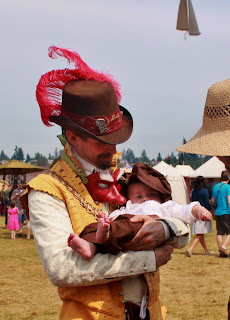When I first started faire, the first thing I read wasn't a history or costuming book. It was a 'Meet & Greet' primer written by someone who called himself Gaffer Applewright.
He had six basic premises that have been my guiding light in the years since:
1. Notice the Patrons.
2. Be Helpful.
3. Be Friendly.
4. Be Your Character.
5. Speak the Speech.
6. The attitude sells it.
It would be six years before I had a chance to meet the man and let him know how much he'd helped me without ever meeting me. He was kind and humble, and told me that if I had found something in his words, then it was in me to begin with.
A more generous actor I cannot imagine working with.
Roger Russell, known far and wide as Gaffer Applewright, died this weekend. I only knew him through the faire. His trademark 'apple trick' (a story he tells as he cuts an apple in a way that makes it come apart like a puzzle) was the perfect, irresistible bit to break down the barrier between the actor and the patron. Like many others, I have long sought to emulate the effortless way that he interacted, the completeness of his characterization.
He was everything I expected from reading his meet & greet paper, a fascinating man with a wise and gimlet eye, a quick wit and a penetrating mind. So it was that I felt greatly honored and somewhat taken aback when one of my companions pointed to him the day I met him and said "that's going to be you in thirty-odd years!"
I can only hope so.
After his speech we had some time to discuss the politics and oddities of renaissance culture, from the search for a cure for scurvy to the nuance of Elizabeth's reign. It was the pinnacle of my time at faire that year and one of the great highlights of my years of doing this thing we call ren faire.
Rest in peace, Gaffer. You will be missed.


.jpg)

.jpg)
